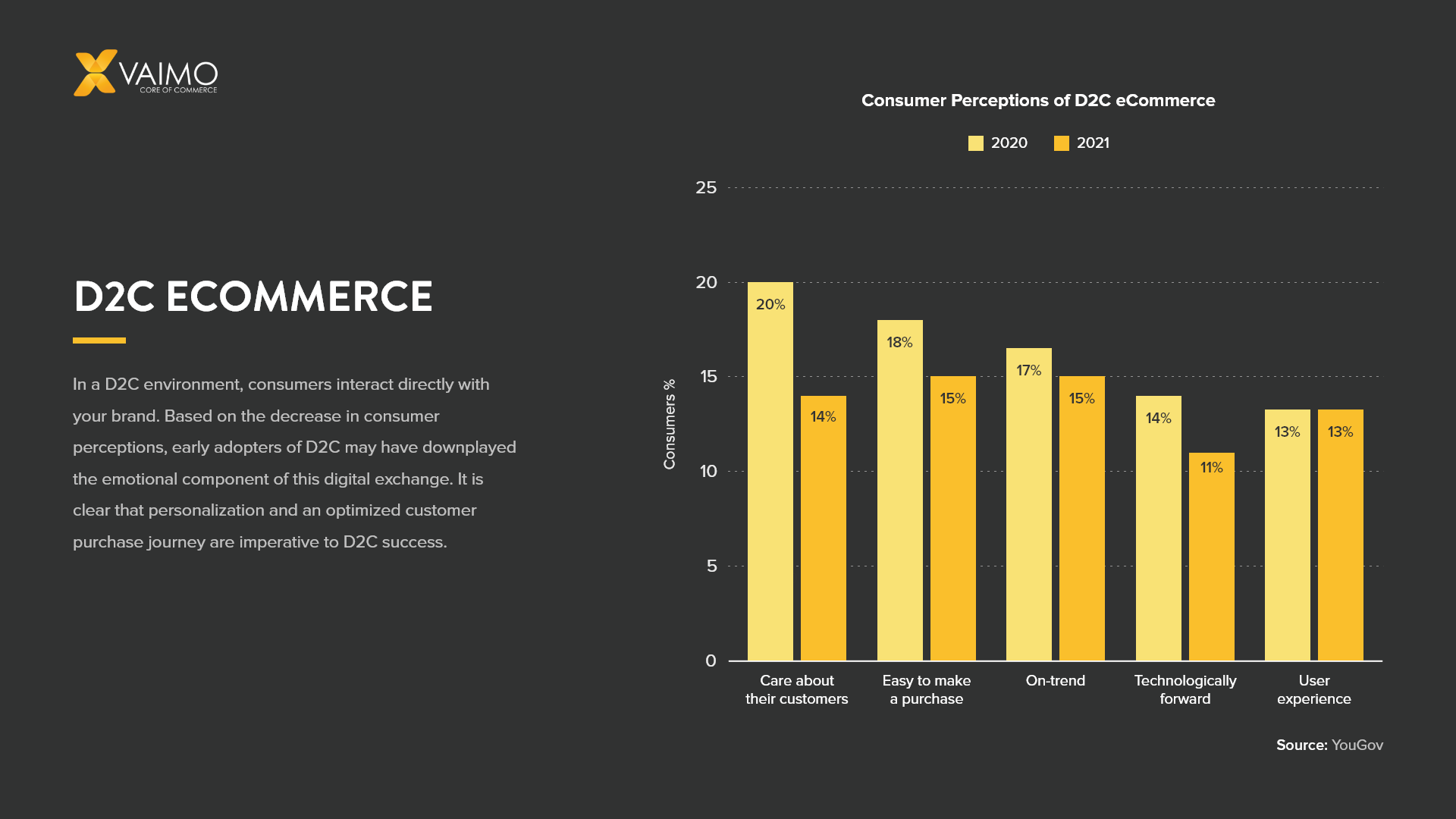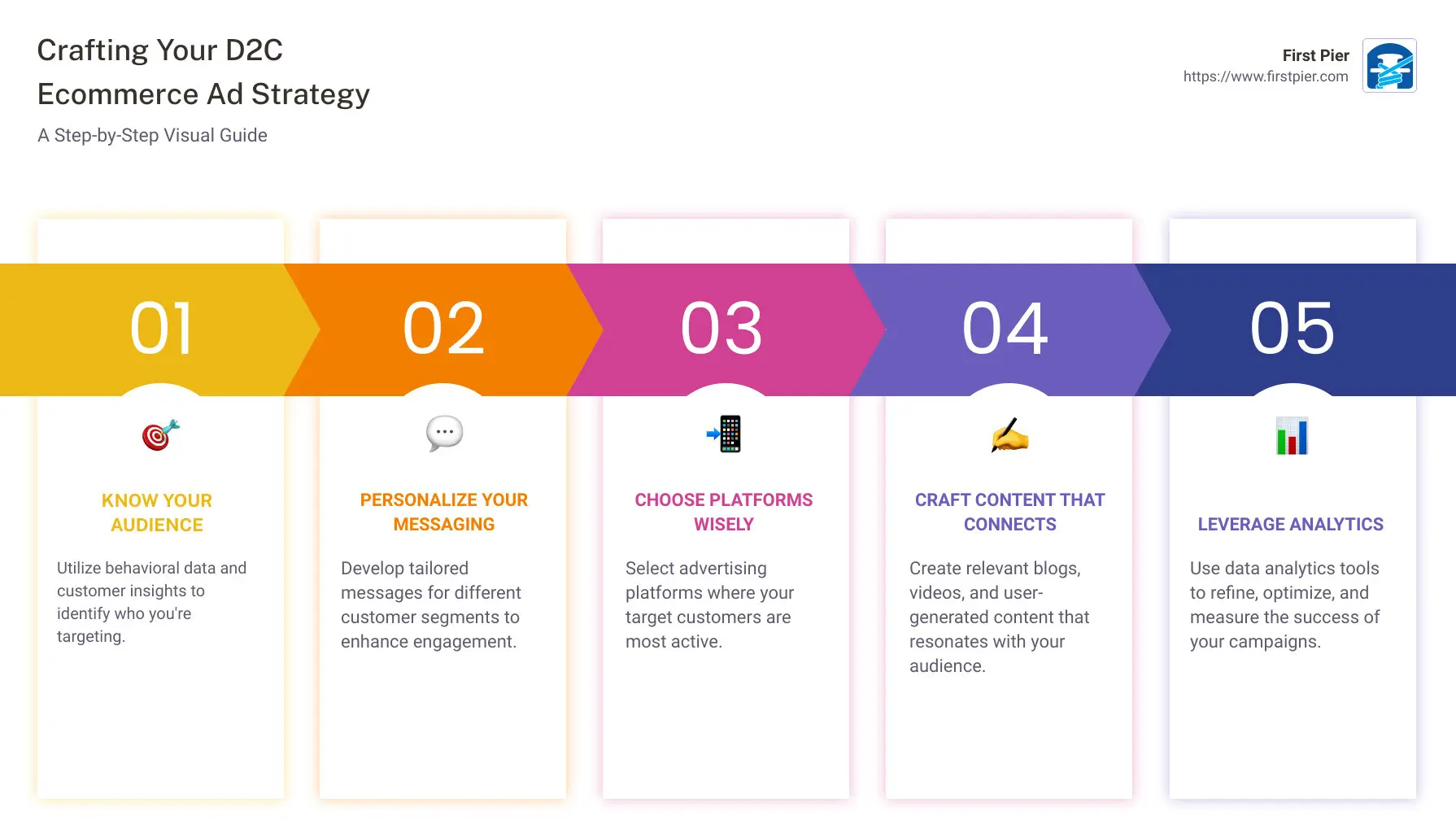Exploring the Possible of D2C Ecommerce: A Comprehensive Guide for Businesses
The D2C ecommerce version provides a substantial change in how brand names involve with consumers. It allows business to bypass standard retail channels, promoting much deeper connections and potentially enhanced profit margins. This strategy is not without its intricacies. Recognizing the subtleties of D2C ecommerce is vital for brand names aiming to thrive. What approaches can they adopt to navigate this progressing landscape effectively? The answers may redefine their company approaches.
Comprehending the D2C Ecommerce Version

Secret Advantages of D2C Ecommerce for Brands
The D2C ecommerce version offers brands considerable advantages, particularly pertaining to raised earnings margins. By getting rid of middlemans, business can preserve a larger share of sales profits. In addition, this direct connection with customers promotes boosted brand name commitment, encouraging repeat purchases and long-lasting engagement.
Raised Profit Margins

Enhanced Brand Commitment
Structure on the monetary benefits of D2C ecommerce, boosted brand name commitment becomes an additional vital benefit for business engaging directly with consumers. By establishing a straight connection, brands can foster deeper relationships with their clients, gaining understandings right into choices and actions. This direct communication enables for more personalized advertising methods, which resonate strongly with consumers. Furthermore, brands have the chance to control their messaging and customer experience, reinforcing brand values and constructing trust fund. When consumers feel an individual link, they are more likely to return, advocate for the brand name, and participate in area interaction. Eventually, improved brand loyalty not just drives repeat purchases but additionally grows a passionate client base, further strengthening a brand's setting in the marketplace.
Obstacles Dealt With by D2C Brands
D2C brands run into a number of significant difficulties that can impact their success. Stock management problems can cause equip lacks or excess, complicating operations and client satisfaction. In addition, advertising and marketing budget plan constraints often limit the capability to successfully reach and involve target market.
Stock Monitoring Issues
Reliable inventory administration provides a powerful challenge for many brands running in the direct-to-consumer (D2C) space. These brand names typically face varying demand, which can cause overstock or stockouts, ultimately affecting consumer contentment and income. Additionally, the lack of innovative stock tracking systems can result in discrepancies between actual stock degrees and reported information, making complex order fulfillment. The diverse series of items D2C brand names usually supply also complicates supply management, as variations in designs, colors, and dimensions call for more thorough oversight. Moreover, numerous D2C services may have problem with restricted warehousing capabilities, bring about ineffective use space and sources. Efficient stock monitoring stays a vital obstacle for D2C brands aiming for sustainable development and operational performance.
Advertising And Marketing Budget Constraints
Navigating marketing spending plan restraints is a considerable difficulty for numerous direct-to-consumer (D2C) brand names. Restricted monetary sources usually limit these companies' ability to purchase all-encompassing marketing strategies, leading to reduced visibility in a competitive market. D2C brands frequently grapple with the requirement to take full advantage of return on financial investment (ROI) while targeting particular audiences successfully. This difficulty is exacerbated by rising expenses in electronic advertising and the requirement to allocate funds across several networks, consisting of social networks, internet search engine, and email advertising and marketing. Consequently, several D2C brands need to innovate cost-effective marketing solutions, leveraging organic development methods and influencer partnerships. Ultimately, efficiently steering these budget restraints is crucial for sustaining growth and achieving long-lasting earnings in the advancing ecommerce landscape.
Strategies for Constructing a Successful D2C Ecommerce Organization
As consumers significantly look for direct links with brand names, developing an effective D2C ecommerce business needs a strategic method that prioritizes consumer involvement and trust fund. One efficient approach is to develop compelling brand name stories that resonate with target market, cultivating emotional connections. Utilizing social media systems can improve exposure and help with two-way interaction, allowing brands to involve straight with customers.Moreover, individualized experiences via customized advertising and marketing initiatives can significantly improve consumer retention and commitment. Executing commitment programs and supplying exclusive bargains can additionally incentivize repeat purchases.Streamlining the buying procedure is crucial, making certain a straightforward interface that enhances the purchasing experience. In addition, clear interaction regarding shipping and returns builds count on and urges consumer confidence.Finally, actively seeking customer responses and replying to it shows a dedication to improvement and consumer contentment, critical components in the competitive D2C landscape.
Leveraging Technology for Improved Consumer Experience
In today's competitive D2C ecommerce landscape, innovation plays an essential function in shaping customer experiences. Services increasingly use advanced devices such as expert system, chatbots, and individualized algorithms to improve interactions and enhance the purchasing procedure. By integrating these modern technologies, brand names can give tailored product referrals based on specific preferences and buying actions, fostering an extra engaging experience.Moreover, responsive site designs and mobile applications guarantee that consumers can access solutions perfectly throughout various devices. Enhanced repayment services, including one-click check outs and electronic purses, additionally streamline purchases, making it easier for customers to make purchases.Data analytics likewise makes it possible for organizations to gather insights right into customer actions, permitting for constant enhancement of services and offerings. Overall, leveraging modern technology not only boosts customer satisfaction however also grows commitment, inevitably driving long-term success in the D2C ecommerce sector.
Advertising And Marketing Strategies to Drive D2C Sales
How can brand names effectively capture the focus of consumers in a saturated market? To flourish in the direct-to-consumer (D2C) landscape, brand names need to employ targeted advertising methods. Using social media platforms, brands can involve customers via get more info interactive content, influencer partnerships, and user-generated posts. Customized e-mail campaigns can additionally foster a sense of connection, providing tailored promos based upon customer actions and preferences.Moreover, narration plays a crucial role in distinguishing a brand's story, making it remarkable and relatable. Brands need to invest in search engine optimization (SEO) to enhance visibility, ensuring their products are easily discoverable online. Additionally, leveraging information analytics enables businesses to fine-tune their marketing methods and comprehend customer trends better. Ultimately, a multi-channel strategy that combines creativity with data-driven understandings can substantially increase D2C sales, allowing brand names to stick out in a jampacked marketplace.
Future Fads in D2C Ecommerce
With the rapid evolution of modern technology and customer choices, the future of D2C ecommerce is poised for substantial change. Emerging fads indicate a shift towards hyper-personalization, where brands take advantage of information analytics to customize offerings to individual consumer requirements. This modification enhances consumer experiences, cultivating loyalty and engagement.Moreover, sustainability is becoming a crucial variable, with consumers significantly favoring brand names that focus on environment-friendly methods - D2C Ecommerce Agency. Companies are expected to take on clear supply chains and lasting materials to meet this demand.The combination of expert system and enhanced fact will in addition reinvent the shopping experience, enabling consumers to visualize products in their atmospheres before purchase. On top of that, social business is prepared for to expand, as platforms like Instagram and TikTok assist in seamless shopping experiences straight within social media.These patterns collectively symbolize a dynamic future for D2C ecommerce, highlighting customer-centric methods and cutting-edge technologies that redefine customer interactions
Regularly Asked Inquiries
What Industries Benefit Most From D2C Ecommerce?
The existing inquiry highlights markets that flourish through direct-to-consumer (D2C) ecommerce. Extremely, style, appeal, electronic devices, and food fields utilize D2C versions to raise brand name loyalty, enhance customer partnerships, and maximize revenue margins effectively.
Just How Do Delivering Costs Influence D2C Prices Methods?
Delivering prices significantly influence D2C rates methods. Businesses need to balance these expenses with affordable prices, considering client assumptions and profit margins. Effective monitoring of delivery can boost customer contentment and drive sales in direct-to-consumer versions.
What Settlement Choices Should D2C Organizations Deal?
D2C companies should supply diverse repayment options, including credit/debit cards, electronic budgets, and buy currently, pay later on services. This range enhances client convenience, enhances conversion prices, and deals with various customer choices in the on the internet purchasing landscape.
Just How Can D2C Brands Deal With Customer Returns Effectively?
D2C brand names can handle client returns successfully by carrying out easy to use return plans, using pre-paid delivery labels, and making sure timely refunds (D2C Ecommerce Agency). Clear interaction and structured processes enhance client contentment and motivate repeat company
What Lawful Factors To Consider Exist for D2C Ecommerce Operations?
Lawful considerations for D2C ecommerce procedures consist of conformity with consumer protection regulations, information personal privacy policies, intellectual residential or commercial property rights, and taxes demands. Brands need to navigate these intricacies to stay clear of lawful challenges and guarantee smooth procedures. By removing intermediaries, D2C brands can supply competitive rates and foster a more intimate relationship with their customers.The D2C model is identified by its reliance on digital platforms, making it possible for brand names to use social media, online marketplaces, and their very own internet sites to involve with consumers directly. D2C ecommerce facilitates the collection of useful consumer information, making it possible for brands to customize their offerings and advertising and marketing techniques effectively, eventually driving sales and raising margins. Additionally, brand names have the possibility to regulate their messaging and consumer experience, strengthening brand worths and developing trust. As customers significantly seek straight connections with brands, developing a successful D2C ecommerce organization calls for a tactical strategy that prioritizes customer involvement and trust fund. D2C brands can handle consumer returns properly by applying user-friendly return plans, using prepaid delivery labels, and making sure timely reimbursements.
Comments on “How a D2C Ecommerce Agency Can Help You Cut Out the Middleman and Boost Profits”